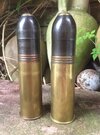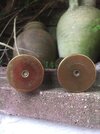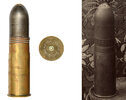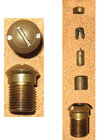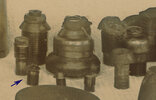I am sure your shell is one of the Boer contract shells imported with the
37mm Krupp/Gruson QF (Schnellfeuerkanone L/30) guns.
The ZAR (Transvaal) imported its first 37mm single-loading QF gun from Hermann Gruson of Magdeburg-Buckau in 1891. This after Commandant-Gen. Piet Joubert attended a firing demonstration at Tangerhülle in 1890 and was dually impressed by the little gun’s “armoured carriage” (i.e. its shield). In 1893 Gruson was bought out by Krupp and became known as Krupp Grusonwerke, from whom the Transvaal ordered three more guns (numbered 1 to 3) in November 1895 through the Johannesburg-based agency of “Fried. Krupp Grusonwerke South African Agency”.
Unlike the better known 37mm Maxim-Nordenfelt/Vickers-Maxim "Pom-Pom" guns, these were light single-loading mountain guns. The barrel was equipped with a vertical wedge breech block with an internal striking bolt. The breech action was worked by a lever on the right hand side of the gun. The barrel was mounted on a light cylinder trailed carriage with a spade-shaped end and was sometimes equipped with a shield. Elevation and depression (15º to either side) was achieved by a small two-part telescopic screw turned by a horizontal hand wheel situated on the left of the breech, while some sources also states that the barrel could also be traversed between 2º and 7.5º to either side. The assembly’s light weight enabled it to be towed by a single horse, or if necessary, hitched behind a wagon. Ammunition consisted of cast iron common shell and case shot fitted to brass casings filled with smokeless powder. As on most other QF equipment a copper driving band was fitted to the base of the shells. Due to the similarities between this gun’s ammunition and those of the better known “Pom-pom”, historical works often incorrectly referred to these guns as Pom-poms.
The Free State imported one gun of this calibre, but according to one sources it was a field gun version. The only notable differences between the field and mountain guns is said to have been the weight of the ammunition (?). Another possible difference could be that the mountain version was manufactured for transport on the back of mules, while the field gun version was towed with a limber. It is not certain when the Free State gun was ordered, which makes it difficult to say whether it was bought from Gruson or Krupp. The Free State ordered three more guns from Krupp before the war broke out in 1899, but these could not be delivered due to the British Royal Navy blockades.
At the outbreak of the Boer War two of the Transvaal guns were sent to the Natal border and two to the North-Western (Mafeking) Front. The Free State gun saw action in the battles of the Western (Kimberley) Front and later in the Free State during Gen. Christiaan De Wet’s early guerrilla battles.
During the war British forces found one of the three Transvaal Krupp guns, complete with its shield, at Pretoria on 5 June 1900, while the single Gruson gun was discovered buried at Piet Retief in February 1901. A third “37mm Q.F. single-loading” gun was accounted for near Lydenburg on 26 April 1901. Some War Office lists (WO32/8111) refers to it as a Hotchkiss, but since the Boers possessed no Hotchkiss guns, this must have been a Krupp-Gruson. The Free State “3cm” gun was captured at Bothaville on 6 November 1900.
After its capture the gun taken from Pretoria was sent “Home” (England) aboard the Templemore, while three more guns, No.12963, 41001 and 41002 left South Africa on 10 October 1903 aboard the SS Inyati. The number “12963” is a Grusonwerk factory number that appeared on the carriage of gun No.2, while 41001 and 41002 are typical Gruson “D.R.P.” numbers and not gun serial numbers. This indicates that two of the Boer guns might have been manufactured before Gruson was bought out by Krupp. One certainly belonged to the Transvaal; did the second belong to the Free State?
In Britain one of the captured guns was kept at “R.I.S.I. Whitehall” for some time, while a second was issued to the “U.S. Institution”. In 1904 No.41001 was shipped to Canada, another, ) went to Tasmania in 1905 and a third was allotted to the Town Clerk of Rochester in the UK (no number given).
One trophy gun, believed to have been the Transvaal Gruson, was discovered in Brimfield, Massachusetts in the USA. The present owner bought the gun from an iron monger, but it is said to have originated from Canada. The breech carries the number 41001, while the trunnions are marked 49kg and 1889. This date and DRP number correspond with the Transvaal’s “Piet Retief” gun imported in 1891 and issued to Canada in 1904. It is currently mounted on a 60mm Krupp BL mountain gun’s carriage.
The Tasmanian gun (No 2, mounted on carriage No.12963) also survived and is today kept at the Queen Victoria Museum in Launceston.
In South Africa a single Transvaal 37mm Krupp QF survived (No.3 mounted on carriage, No.12964).
ZAR gun No 4 or the OVS gun is probably the one on display at Upnor Castle in Kent, England, but I have been, to date, unable to confirm its serial number.
(
https://wargamingmiscellany.blogspot.com/2014/09/i-have-been-to-upnor-castle-kent.html)
It is not known whether gun No.1 (mounted on carriage No.12962) was ever captured by British forces.
Full article with photos here:
https://www.angloboerwar.com/images/pdf/OVSAC_11_BoerKruppGuns_Rev1.pdf
Some more Boer 37mm shell info here:
https://saartillery.wordpress.com/archives/anglo-boer-war/mystery-shell/
More photos here:
https://www.angloboerwar.com/forum/...ment/31231-artillery-and-ammunition?start=144





